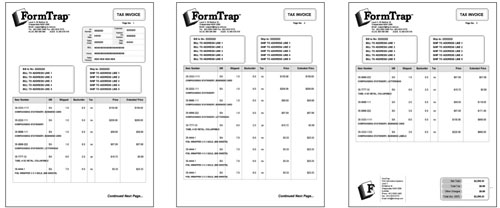
|
Getting Started |
Design Environment |
Design Modes |
Design Concepts Special Features | Projects | Repaginator | FTSplitDef |
| Design Concepts |
 Designing a Static Form
Designing a Static Form
|
 Designing a Dynamic Form
Designing a Dynamic Form
|
| Objects |
 Creating Objects
Creating Objects
|
 Deleting Objects
Deleting Objects
|
 Arranging Objects
Arranging Objects
|
| Page Elements |
 Creating Page Elements
Creating Page Elements
|
 Deleting Page Elements
Deleting Page Elements
|
 Arranging Page Elements
Arranging Page Elements
|
| Preview the Forms |
 Preview the Forms
Preview the Forms
|
| Designing a Dynamic Form |
|
|
A Dynamic form is more flexible but in being so is also more complex to design. You would use a Dynamic form if you want the Page headers to have less detail on pages after the first page of a document, or if you want your Page footer on the final page to carry trailer details, or even if you simply want to fit more details onto the non-terminating pages of a document. The design process for creating a dynamic form harnesses many of the advanced features of FormTrap. A dynamic form is one on which the framework is not fixed, but will print in different positions according to the size of headers and footers. Little is defined on the Base page and the area in which details print will also be defined dynamically page to page as the form is printed. A dynamic form is characterized by:
|
|

